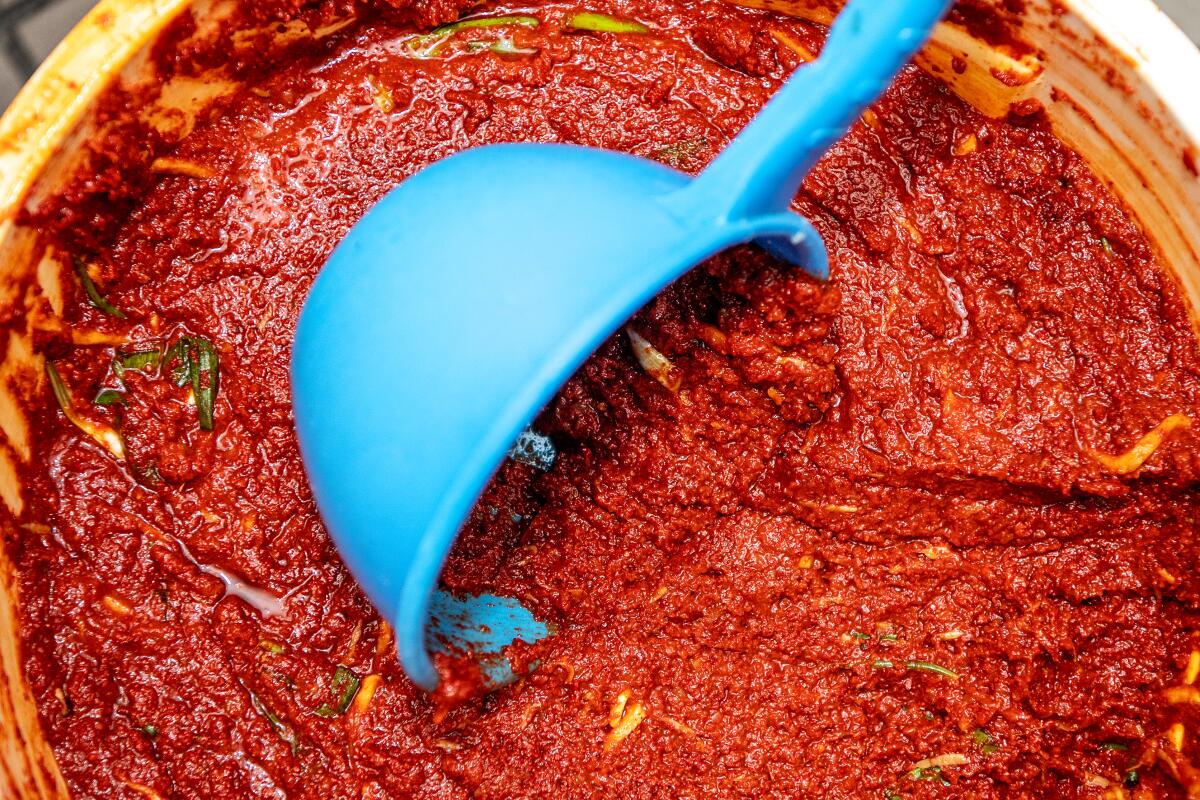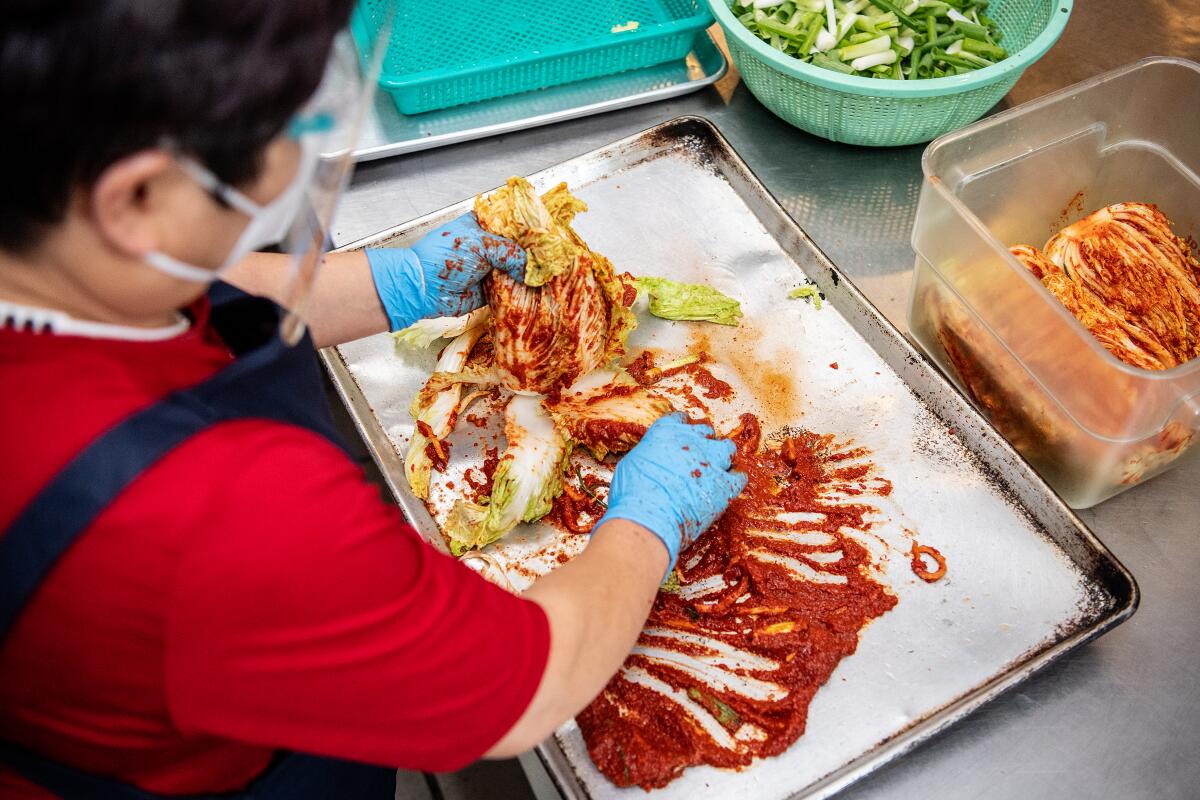Kimchi is everywhere. At these Koreatown shops, kimchi is everything and more

It might not look like much from the outside, but like so many of L.A.’s jewels, you can only appreciate a place like Kae Sung Market when your nose leads and legs follow.
When the front door is left ajar and the breeze favors you, the sharp bite of minced garlic and spice carries out of the kitchen to entice passersby. Walk into the market and you’ve entered a kimchi wonderland. Behind glass refrigerator doors, nearly every inch of shelf space at the small Koreatown shop is filled with jars and tubs of kimchi. There are at least 15 varieties of kimchi made here. Fresh batches are prepared daily.
One of the best parts of the job is when someone ‚ÄĒ especially someone new ‚ÄĒ walks through the door, said co-owner Guiyoung Yang. For him, it‚Äôs an opportunity to share what he‚Äôs known for a while: His wife makes the best kimchi.
‚ÄúShe‚Äôs always been good at making kimchi, ever since Korea,‚ÄĚ said Yang.
Kyungsook Oh prefers to let her husband and their two sons, Hyunwoo Yang and Inwoo Yang, do most of the talking. She lets her work speak for itself.
‚ÄúIt‚Äôs all made by hand, and [customers] trust that it‚Äôs clean. We only use the top ingredients, even when it‚Äôs difficult,‚ÄĚ Oh said. ‚ÄúWe‚Äôre really grateful that people enjoy our kimchi.‚ÄĚ


Before the pandemic, the family relished opportunities to make a connection with walk-in customers.
‚ÄúAs a small business, it‚Äôs very enjoyable and important to talk to customers because when they come and ask about all the ingredients and types of kimchi, we want to explain it to them and let them taste it,‚ÄĚ said Guiyoung Yang. ‚ÄúBut [COVID-19] changed all that. We can‚Äôt do that anymore.‚ÄĚ
Building relationships with customers is critical for standalone kimchi shops like Kae Sung Market.
Kimchi, after all, is more accessible than ever: Korean grocery stores keep their shelves fully stocked, and around Korean population centers, supermarket chains and big-box stores like Costco, Target and Walmart also sell it. To distinguish themselves, independent kimchi shops try to focus on quality and specific tastes.
An incomprehensive but indisputably correct guide to the great kimchis of Los Angeles.
At Kae Sung Market, they make kimchi in the style of Kaesong, a North Korean border city and hometown of the shop’s founder and original owner, Sook-jae Cho. Cho and her family fled Kaesong during the Korean War, and in the 1970s she immigrated to Los Angeles, where she began to make and sell kimchi to earn money to buy a plane ticket home to see her family. In 1993, she opened Kae Sung Market, where her sisters would join her in making some of the best kimchi in Koreatown.
When Cho retired and sold the shop in 2018, Kae Sung Market didn’t fall into the hands of a kimchi novice. Oh had worked in several Koreatown restaurants since she and her family arrived in the United States from Seoul in 2007. The family had been searching for a business to call their own, and it was Oh’s reputation and prowess in the kitchen that helped them achieve their dream. Cho eschewed other buyers and sold the restaurant to the family.

‚ÄúOur mother was working in a lot of restaurants, and she got a lot of recommendations from here and there,‚ÄĚ said Hyunwoo Yang.
It helped too that the family’s tastes aligned with Kaesong-style kimchi, which tends to have a lighter flavor because it uses a moderate amount of sok, a mixture of gochugaru (red chile pepper), saeu-jeot (salted fermented shrimp), garlic, ginger, fish sauce and other ingredients that’s applied to the napa cabbage leaves prior to fermentation.
Kaesong was the capital of the Korean peninsula under the reign of the Goryeo Dynasty, which lasted from the 9th to the 13th century, until it was moved to Seoul. ‚ÄúEven after the Korean War, when Korea was divided by north and south, that [tradition] continued. Seoul kimchi and Kaesong kimchi are alike,‚ÄĚ according to Hyunwoo Yang.
A deep sense of community marks the Korean food staple’s long history.
At Kimchi Plus, just a few blocks southeast of Kae Sung Market, owner Young Hi Kim also opts for a more subtle taste by using less saeu-jeot in her sok. She opened and cooked at several Koreatown restaurants before launching Kimchi Plus in 2015 ‚ÄĒ and she has been spreading the gospel of kimchi and Korean cuisine since moving to the United States from Seoul about 25 years ago.
Kim owned and ran a successful restaurant in South Korea before she sold it to take part in a government-sponsored effort to promote Korean food globally. The campaign was created with several goals, including the opening of more Korean restaurants overseas and supporting respected Korean cooks like Kim by teaching and reinforcing traditional methods and certifying them as ambassadors of hansik or Korean cuisine.
‚ÄúKimchi is the most common and popular traditional Korean food,‚ÄĚ said her daughter, Mina Kim. ‚ÄúShe wants to make her food enjoyable to [non-Koreans].‚ÄĚ


Since opening, Kimchi Plus has shifted its business to offer more catering ‚ÄĒ the ‚Äúplus‚ÄĚ in Kimchi Plus.
‚ÄúWe used to just do kimchi, but now we‚Äôre making a lot of other food,‚ÄĚ said Young Hi Kim, who leads her staff daily to churn out a variety of banchan options and food for events and nearby office buildings ‚ÄĒ many of which have closed or scaled back their orders while workers stay at home during the pandemic. (These days, Kimchi Plus delivers many of its hot meals to senior centers across the Koreatown area.)

Like restaurants and other food-service businesses, kimchi shops were hit by high and fluctuating prices for ingredients when the pandemic first began. Kae Sung Market buys its cabbage at auction. Prices typically run $16 to $20 for a 50-pound box but went as high as $50 before falling down to around $35 in March, said Richard Byun, who helps the family run the shop. (The price has since settled down, at $18 to $20 per box.)
At the onset of the pandemic, while some people were hoarding toilet paper and all-purpose flour, Byun said customers at Koreatown markets were stocking up on other essentials.
‚ÄúThe most items sold were kimchi and rice,‚ÄĚ said Byun.
Making kimchi is easy, and there’s perhaps no teacher who’s more accessible and better than Maangchi.
Kae Sung Market also sells its kimchi to several Korean grocery stores in Los Angeles and Orange counties: Hannam Chain locations in Koreatown, Garden Grove and La Palma; Arirang in Fullerton; and, in Koreatown, HK Market, Zion Market and both Galleria locations.
The family has done its best to adapt and connect with its changing neighborhood.
‚ÄúSince we first arrived [in Koreatown], there‚Äôve been a lot more buildings and apartments going up on Wilshire and Olympic,‚ÄĚ said Guiyoung Yang. ‚ÄúEven the smaller streets are changing.‚ÄĚ

Korean is the family’s first language, but that has never deterred them from sharing their kimchi with English-speaking walk-in customers.
‚ÄúNon-Koreans, especially younger people, are coming to the store, and they like to taste the kimchi before they buy,‚ÄĚ said Guiyoung Yang. ‚ÄúOne of the best feelings is after you make kimchi and you taste it, and you‚Äôve achieved a taste ‚ÄĒ your desire.‚ÄĚ
Customers favor Kae Sung Market’s mak (cut napa cabbage) and kkakdugi (cubed radish) kimchis, but the family’s personal favorite is poggi, or whole napa cabbage kimchi.
‚ÄúIt can last for six months, and it gets better as it ferments,‚ÄĚ said Hyunwoo Yang, noting that well-fermented kimchi makes for better kimchi jjigae (stew). ‚ÄúWe get a rewarding feeling when other people taste and enjoy our kimchi. It makes us happy.‚ÄĚ
Kimchi Plus actually saw a bump in walk-in customers when the pandemic first shut down restaurants and business throughout L.A.

‚ÄúPeople seem to eat at home, so they need to stock up their fridge, so they would come here and buy some kimchi,‚ÄĚ Mina Kim said.
To get the most out of her kimchi, Young Hi Kim recommends that it sit in the jar for two days before consuming. Her customers seem to enjoy her yeolmu (young summer radish) kimchi, she said. But if you want her recommendation, go with her classic napa cabbage kimchi.
‚ÄúI‚Äôve eaten it since I was a child,‚ÄĚ she said. ‚ÄúI‚Äôve eaten it since I was born.‚ÄĚ
More to Read
Eat your way across L.A.
Get our weekly Tasting Notes newsletter for reviews, news and more.
You may occasionally receive promotional content from the Los Angeles Times.













